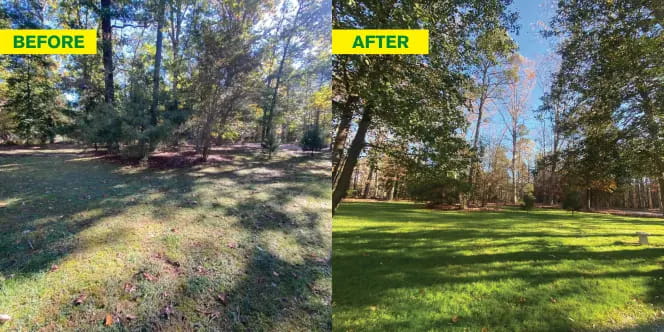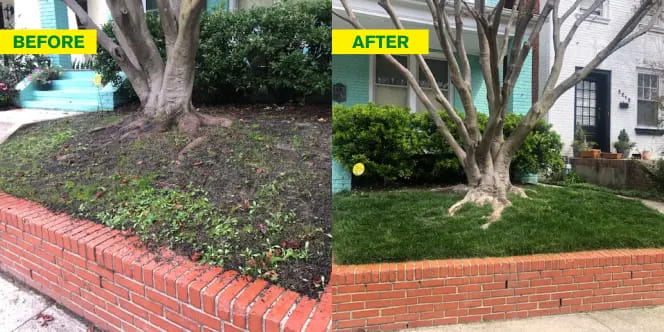A Short Guide to Cost Effective Lawn Care
A lush, bright green lawn is one of those things that can really make a homeowner proud. Few people want to buy property that doesn’t have a lawn of some sort. It’s one of the reasons that so many real estate agents tell sellers to clean up their yard as a way to boost their property’s curb appeal. In a way, the lawn is like a status symbol of sorts that comes with home ownership.
Topics Index
- How Much Does Lawn Care Cost?
- Why Is Timing of Lawn Care Important?
- Spring Lawn Care
- Summer Lawn Care
- Fall Lawn Care
- Winter Lawn Care
- Do I Need to Water My Lawn?
- Why Should I Use Fertilizer?
- Do I Need to Aerate My Lawn?
- Should I Use Compost Instead of Fertilizer?
- How Do I Mow My Lawn?
- Why Should I Seed My Lawn?
How Much Does Lawn Care Cost?
Of course, one of the drawbacks of having a lawn is that it can be a costly expense. According to HomeAdvisor, lawn care can cost roughly $100 to $200 a month in some cases. This is without taking into account major repairs or the size of your lawn and the extent of your landscaping. Fortunately, if you take care of your lawn properly, it will keep maintenance costs down. If you ignore your lawn, it may end up costing you more to repair or restore the grass and soil over time. The following is a guide to cost effective lawn care that you should follow to keep your lawn beautiful and healthy, while keeping costs down.
Why Is Timing of Lawn Care Important?
The different seasons have a big impact on the condition of your lawn and when the best time to care for it is. For example, grass usually goes dormant during the winter. It’s also generally too cold for grass to grow. Spending money and time on lawn care during this period is probably not very cost-effective, although there are still a few things you can do to care for your lawn during the winter.
The following are some of the lawn care tips that you can employ during each season to ensure your lawn is healthy all year round:
Spring Lawn Care
When mowing the grass, keep it on the longer side so that it will be more capable of photosynthesis and of developing healthy root systems. Once your grass begins growing again, make sure to remove any weeds. Throughout the spring you should be fertilizing your lawn.
Summer Lawn Care
Your grass is going to grow faster during the summer than at any other point during the year because of the amount of sunlight that it will be getting. This is especially true if you took care of your lawn during the previous spring season. Because of this, you’ll need to mow your grass regularly.
You’ll also need to water your lawn regularly as well. There’s a good chance you’ll need to water more often than usual, so pay attention to the weather and to the color and texture of your grass to determine if your lawn is being watered enough.
Fall Lawn Care
Because of the stress your lawn experienced during the summer heat, the fall is the best time to reseed. Reseeding will be necessary if there was a drought during the summer as well. Be sure to use a starter fertilizer in the fall for new seed that has been planted followed by a higher Nitrogen fertilizer to help establish it before winter. Additionally, keep mowing until the grass growth starts to slow down.
Additionally, keep mowing until the grass growth slows.
Winter Lawn Care
With the arrival of winter, it is important to remember to keep debris such as leaves, pine needles, pinecones, gum balls, acorns, and sticks off your lawn. Also, be careful of walking on the grass covered in frost which can cause damage.
Dial In Your Lawn’s Nutrients
A quick soil test helps target fertilizer and lime rates for healthier, greener turf and lower costs.
Do I Need to Water My Lawn?
You may assume that any water your grass needs will be supplied when it rains, right? Wrong. Rainwater is rarely enough to keep your lawn healthy, but even if you are watering your lawn, you may still not be providing your grass with enough water. Other common watering issues include overwatering and not watering at the proper times. The following are a few of the tips you should keep in mind when watering your lawn:
When Is the Best Time to Water My Lawn?
Watering your lawn is most effective in the morning. This is because the temperatures will still be cool, allowing the water the time it needs to soak deep into the soil. Watering in the afternoons is a challenge because the sun will end up evaporating a large percentage of the water, which means that either your grass won’t get as much water as it needs or you’ll end up wasting water in order to compensate. Watering in the evenings isn’t the best idea either since it might stick to the grass blades overnight, which could result in the development of various lawn diseases.
How to Water My Lawn with Sprinklers?
Simply watering the surface of your lawn isn’t going to do it any good. The water needs to reach the roots of the grass, which are generally six inches down into the soil. When you first begin watering your lawn, check the soil every 15 minutes to determine how long it takes for the water to soak six inches deep. This will allow you to put your sprinklers on an accurate timer. If you don’t have a timer, get one. It will help prevent you from wasting water, which can have a huge impact on your water bill.
Soil Conditions
Because soil conditions can vary during different seasons, you should test how long it takes for water to soak into the soil whenever the temperatures change drastically, and then adjust your sprinkler timer accordingly.
New Grass
If you’ve planted new grass, use an oscillating sprinkler instead of a pulsating sprinkler. Pulsating sprinklers are great for mature lawns, but they will wash away the seeds in new lawns.
Bonus tip: If your soil is particularly hard, you may need to pause the watering for 30 minutes to let the water soak in before watering again. Otherwise, water will just run off the soil instead of soaking in, which will also waste a lot of water.
Do I Need to Water the Shady Part of My Lawn?
The parts of your lawn that are covered in shade during the day won’t need as much water. However, this doesn’t apply to grass that’s located under the shade of trees. In fact, this area of the lawn may need more water than the grass that is exposed to the sunlight because it’s competing with the roots of the nearby tree for water.
Why Should I Use Fertilizer?
To promote the healthy growth of grass, you’ll want to use fertilizer. Fertilizer contains nitrogen, which is the most important nutrient grass needs to grow. Fertilizing your lawn is what that beautiful, deep green grass. However, the success of your lawn’s growth will depend on when you fertilize and how much you fertilize, so be sure to keep the following fertilizing tips in mind.
When Is the Best Time to Fertilize My Lawn?
The best time to fertilize your lawn is right before your grass enters its peak growing period. When this period occurs depends on the type of grass that you have. For example, if you have a warm-season grass lawn, the best time to fertilize is during the late spring or early summer. If you have a cool-season grass lawn, then you shouldn’t fertilize it until the fall and spring.
As far as how often you should fertilize your lawn, this depends on how often you water. The more water your grass receives, the more fertilizer it needs. This is because water promotes growth, and growing grass needs more nutrients. If you’re using a sprinkler system, fertilize once every six weeks. If you don’t use a sprinkler system, then you can fertilize every eight weeks. However, if you leave lawn clippings on the lawn, then you may only need to fertilize once a year. Lawn clippings will return half of the nitrogen that your grass needs back to the soil.
It is best to fertilize during the spring 3 times, beginning in January and every 6–8 weeks after until as late as mid-June.
Do I Water My Lawn Before or After Applying Fertilizer?
You’ll want to water your lawn a day or two before you plan to apply fertilizer. Once the grass is dry, spread your fertilizer across the lawn and then follow it up with a light watering. This light watering will wash off any of the fertilizer that has stuck to the grass and into the soil. Avoid fertilizing if you know it’s going to rain heavily because then the fertilizer may end up washing away. If your grass has browned because of a lack of water, then this is not the right time to fertilize either.
Watering after fertilizing helps the fertilizer move into the grass and into the soil. Having the lawn well-watered before fertilizing can also aid plant uptake of nutrients as a healthy plant and soil system can promote growth.
Keep Costs Down with a Smart Plan
Our Lawn Care Programs bundle fertilization, weed control, and seasonal timing—so you save time and avoid costly fixes.
Do I Need to Aerate My Lawn?
If your soil is particularly dense, you may want to consider aerating it. This is a process in which little holes are created in the soil, thereby exposing the roots of the grass. By aerating your soil, you’ll make it easier for fertilizer and water to reach the roots. Aeration is only done in the fall on cool season grass.
Should I Use Compost Instead of Fertilizer?
If you don’t want to use a store-bought fertilizer, one alternative option is to use an organic compost mixed with topsoil. The best combination is 75% soil to 25% compost mixture. The use of compost can help prevent nitrogen leaching, which is one of the contributing factors to groundwater contamination. It’s also extremely beneficial because it feeds the grass plus nourishes the soil. Fertilizing using compost works only in the fall at the time of aeration and seeding.
How Do I Mow My Lawn?
Believe it or not, the way you cut your grass can have a huge impact on the health of your lawn. The following are a number of tips that you should follow when mowing your grass:
- Wait until the grass is dry before mowing it. The grass will be upright and will cut down more easily and evenly, and will be less likely to clump than when it’s wet.
- Avoid removing more than a third of the blade length of the grass at a time. Cutting too close can damage the crown and increase vulnerability to pests, disease, soil compaction, and weeds.
- Avoid mowing the lawn if it’s too hot out. Mow in the morning, later in the day, or when it’s overcast.
- Make sure that your mower blades are sharp to prevent rough cuts and disease pressure.
- Change your mowing pattern every time you mow to help grass grow upright.
- If you’ve just seeded new grass, wait around four weeks after germination for the blades to establish before mowing.
Why Should I Seed My Lawn?
You may need to seed your lawn if it’s experienced any damage, whether it’s caused by harsh weather, disease or insects. Even if you take good care of your lawn, spot seeding might be needed to fill out thin areas of your lawn with new grass. If severe damage has been done to large parts of your lawn, then a complete lawn renovation may be required. The following are some of the basic tips that you should keep in mind about seeding your lawn:
- Spot seeding can easily be done by using a rake to break open and cultivate the soil. Apply the seed and then gently tamp down on the soil.
- Seeding can be done in large areas of the lawn that have thinned out by simply spreading seeds once you’ve aerated the soil.
- For a complete renovation, either remove old sod before de-thatching and seeding, or use slice-seeding to drill seed into the soil.
- Although you can seed during any time of the year, the late summer and fall periods are the best time to seed.
- Seeds need to be kept moist until they show good germination.
- Avoid using weed control until your new grass has grown and has been mowed at least four times.
Optimal lawn care takes a lot of attention but it doesn’t have to cost a lot of money. If you follow the tips outlined in this guide, you should be able to keep your lawn healthy and beautiful all year round at a reasonable cost.
For more information on optimal lawn care or to learn about our lawn care services, contact us online or call us at 804-285-6200
Ready for a Healthier, Lower-Cost Lawn?
Get a plan tailored to your lawn’s soil, grass type, and seasonality—so every dollar works harder.



